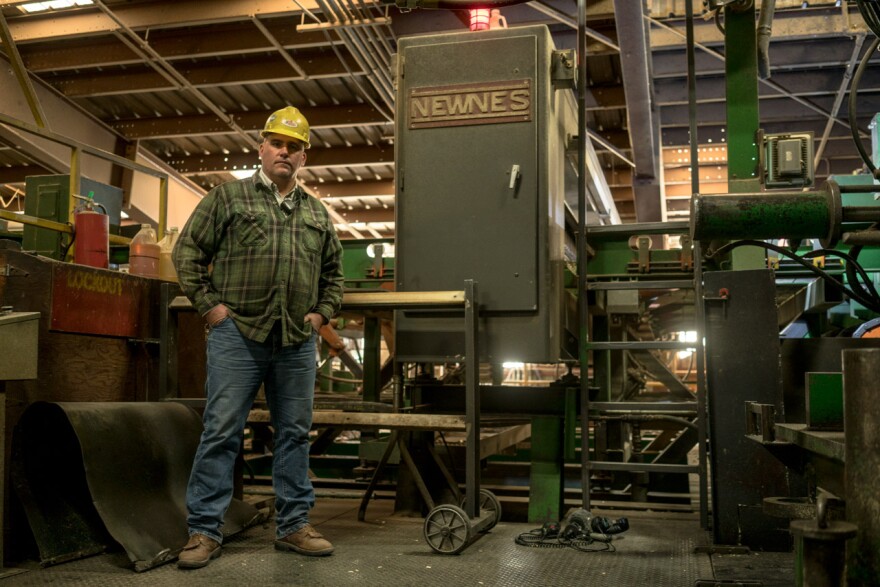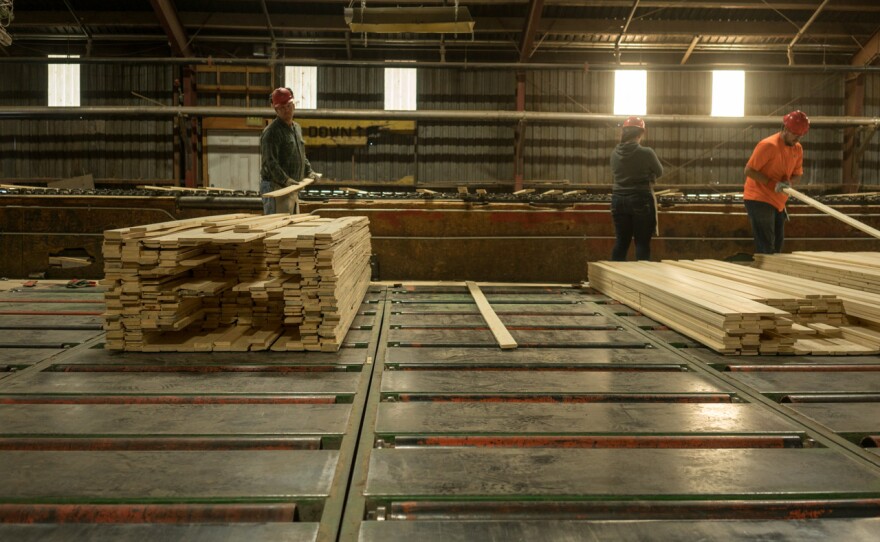Amidst the golden, glowing larches bordering Seeley Lake, freshly cut one-by-fours stream down a sort of disassembly line. This is Pyramid Mountain Lumber Company, and it’s one of increasingly few places in Montana where cut trees are turned into timber.
Workers in red hard-hats grab strips of wood and slide them into piles. But machines have sized up each log, and cut them into perfect proportions. It’s a mostly automated process that cuts logs as efficiently and with as little waste as possible.
Over the last 30 years, the number of workers in mills like this one has gone down by a third. Environmentalists say mechanization is the culprit, while others claim the Forest Service isn’t letting loggers take enough trees off federal land. And here on the line at Pyramid, that debate is playing out.
“Computerization gives you the best decision you can,” says Todd Johnson, the plant manager at Pyramid. “It’s your best operator on his best day every day. It never takes 10 minutes off, it never calls in sick, it never has a bad day.”

Pyramid’s a small, family-run operation that employs about 140 people. Johnson’s grandpa bought the mill in the late 1940s, and he says his father – who’s 82 – is still the first one in every morning. Johnson says he started working here officially in 1988.
“But that’s when I got outta college,” Johnson says. “I started working here in sixth grade. A family-owned business, you’re working here from the time you can start pushing a broom and emptying garbage cans, that’s what you did.”
He’s showing me around the mill, pointing out the newest technology.
“This is our optimized curve sawing gang,” he says, pointing at what looks like a wide-open, grinning mouth, with saw-blade teeth that can shift and bend with the curves of a piece of wood. Johnson says wood isn’t straight. Think of it kind of like a banana.
“And you’re cutting a banana and you’re trying to cut it straight, you’re gonna have less full-length pieces, but if you’re able to saw with the curvature of the banana, you’re gonna have more full-length pieces.”

In the mill, a human used to analyze each log to find the best way to chop it, avoiding deformities and knots, and getting most lumber output. But now, high-tech scanners automatically find the most efficient ways to cut.
So how much has new technology like those scanners and that high-tech saw contributed to the decline in employment?
A new study from the University of Montana’s Bureau of Business and Economic Research says not a lot. It’s lack of access to trees on federal land – not new, high-tech machines – that’s causing the decline of timber mill jobs, the study says.
Todd Morgan, director of the forest industry research program, co-wrote the report. He says he’d been hearing this debate about robots killing jobs, so he thought, “We’ve got a good bit of data. Let’s dig into it and see what it really says.”

The study looks at data from the early 1980s to 2016. It shows a steady decline in both timber harvest and employment starting in the 1990s. There was an especially big plunge in 2009 with the housing crisis. But while the broader economy has been on an upward swing, the timber industry still hasn’t recovered.
So Morgan wanted to see how this all fit together. He ran the numbers, and he found, “It was actually the harvest trend that was really driving it,” he says. “It was four times more important statistically in the model than the next most important thing, which was the productivity measure.”
So this means that when the total tree harvest in Montana went down, employment also took a dip. But when new technology came along and worker productivity went up – sometimes the number of jobs climbed too.

National Forest harvests in Montana in recent years were about a sixth of what they were in the late ‘80s. But the Forest Service under the Trump administration has set higher goals for the years to come.
“The take-home message is that if we do see increases in harvest in the state, and in particular with National Forests, they’re talking about increasing their harvest levels, then that would and probably will translate to more jobs in the forest industry in Montana,” Morgan says.
Back at Pyramid, plant manager Todd Johnson is pointing to more hulking machinery. He says the BBER’s study sounds about right.
“There have been a lot of sawmills going out of business, and that’s primarily due to log supply,” Johnson says. “Available timber supply close to the mill is always gonna be the driver of the economic engine of our industry.”
He says the mill’s only running four shifts a week due to the low supply of logs coming in, and they’d like to be running at least five.
“There’s really only been – at least at our sawmill – in the last, say, 25 years, only one big project that’s eliminated a lot of labor, and that's been when we automated the green chain back around 1990,” he says.
The green chain was a line of folks manually sorting recently cut boards before drying them out. It was tough work, and Johnson says that sort of labor is hard to find anyway. Now, he says there’s still some manual sorting that happens – like I’d seen on the line earlier – but the bulk is automated. And he says while technology might take away some jobs, it can actually create new, higher-paying positions for operators.
“You may invest in something that may eliminate one or two jobs, but you’re doing that in order to protect the other 140 jobs,” he says.
So small mills like Pyramid need new, high-tech equipment to survive in a competitive market.
But when Thomas Power, an economist at the University of Montana, looks at Morgan’s study, he says not so fast. He’s been studying the economics of logging in the Northwest for 50 years.
“The idea that the primary source of the job loss is the failure of the federal government to harvest enough trees totally ignores the fact that how many trees you harvest is at least partially – one would hope – tied to what the demand for those trees is,” Power says.
Economics 101: there’s supply – where the material is coming from - in this case, forests. And there’s demand – how many people are actually buying the stuff. Power says this study doesn’t take demand into account at all. Plus, he says lots of wood production has shifted to the U.S. Southeast and to British Columbia.
And taking a further step back, he says the study’s too narrow.
“I’m not sure that we get an answer from that study because one of the important changes in the forest products industry is how it is we harvest trees now,” Power says.
He says the study only looks at one side of the industry: what happens in the mills. It ignores the other part of the business: how trees are cut down. And over the decades, logging has gone from two-person crews felling trees by hand, to chainsaws, to increasingly high-tech mechanical marvels that mow down trees quicker and with ever fewer people involved.
“I think there’s no denying the fact that if we look back over a century of timber harvest in Western Montana or anywhere in the United States, technological change has eliminated tens of thousands of jobs,” he says.
But Power does think there’s something to the study, which only looked at Montana timber mills. He says operations like Pyramid are typical for Montana, but unique for the Northwest as a whole. Most mills here are small, but farther west, larger, more mechanized operations run the show.

“Montana doesn’t have many large mills anymore,” Power says. “And so it may be that technological change in that size of mill in Western Montana has not played much of a role in declining employment.”
Back at Pyramid, plant manager Todd Johnson says despite all these changes, the timber industry isn’t going away anytime soon.
“There’s always gonna be a need for timber,” Johnson says. “There’s always gonna be a need. There’s a way to treat the ground right. There’s a way to solve our issues on our national forests with health or fire or salvage, or whatever it is. There’s a way to do it right.”









